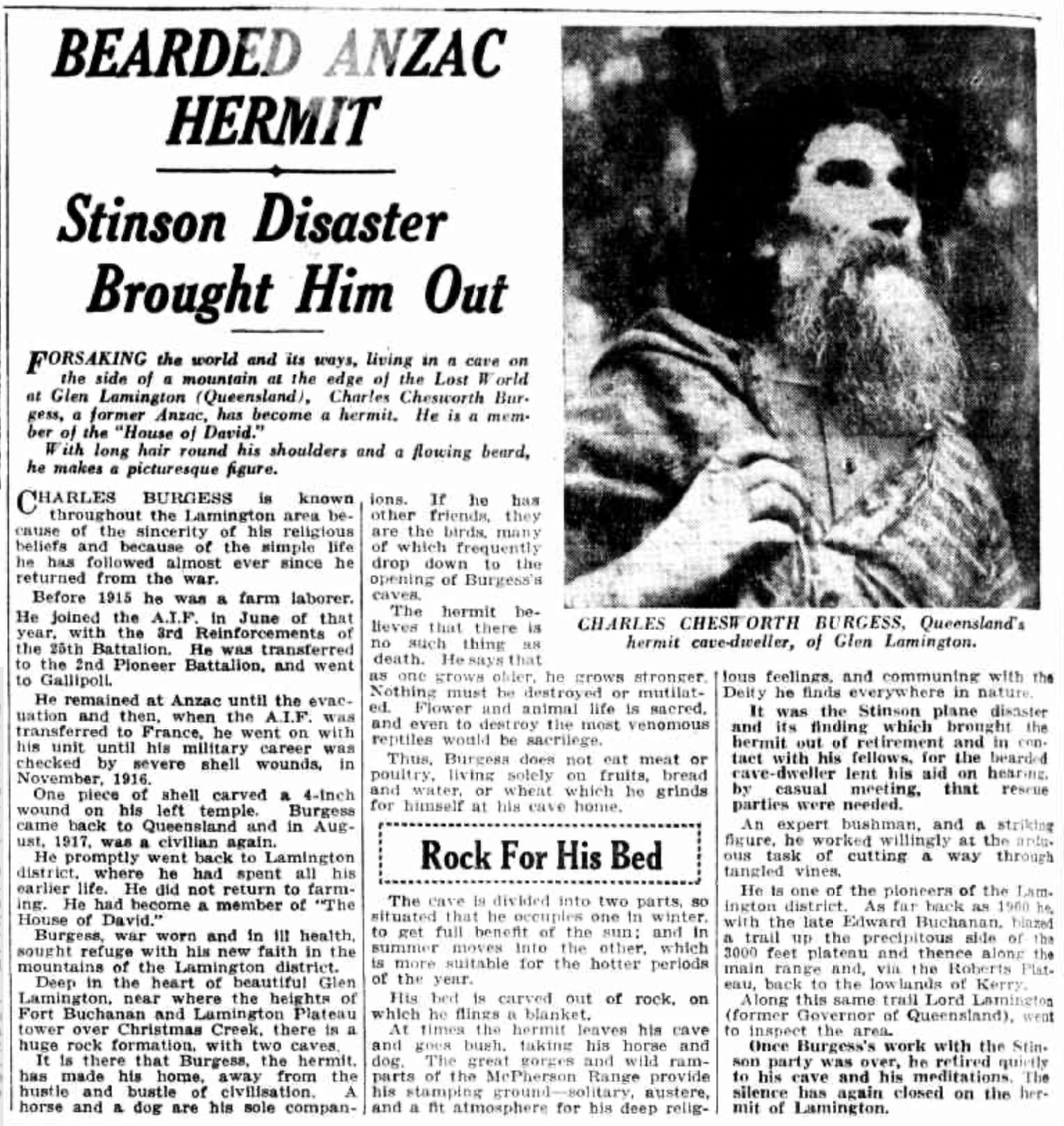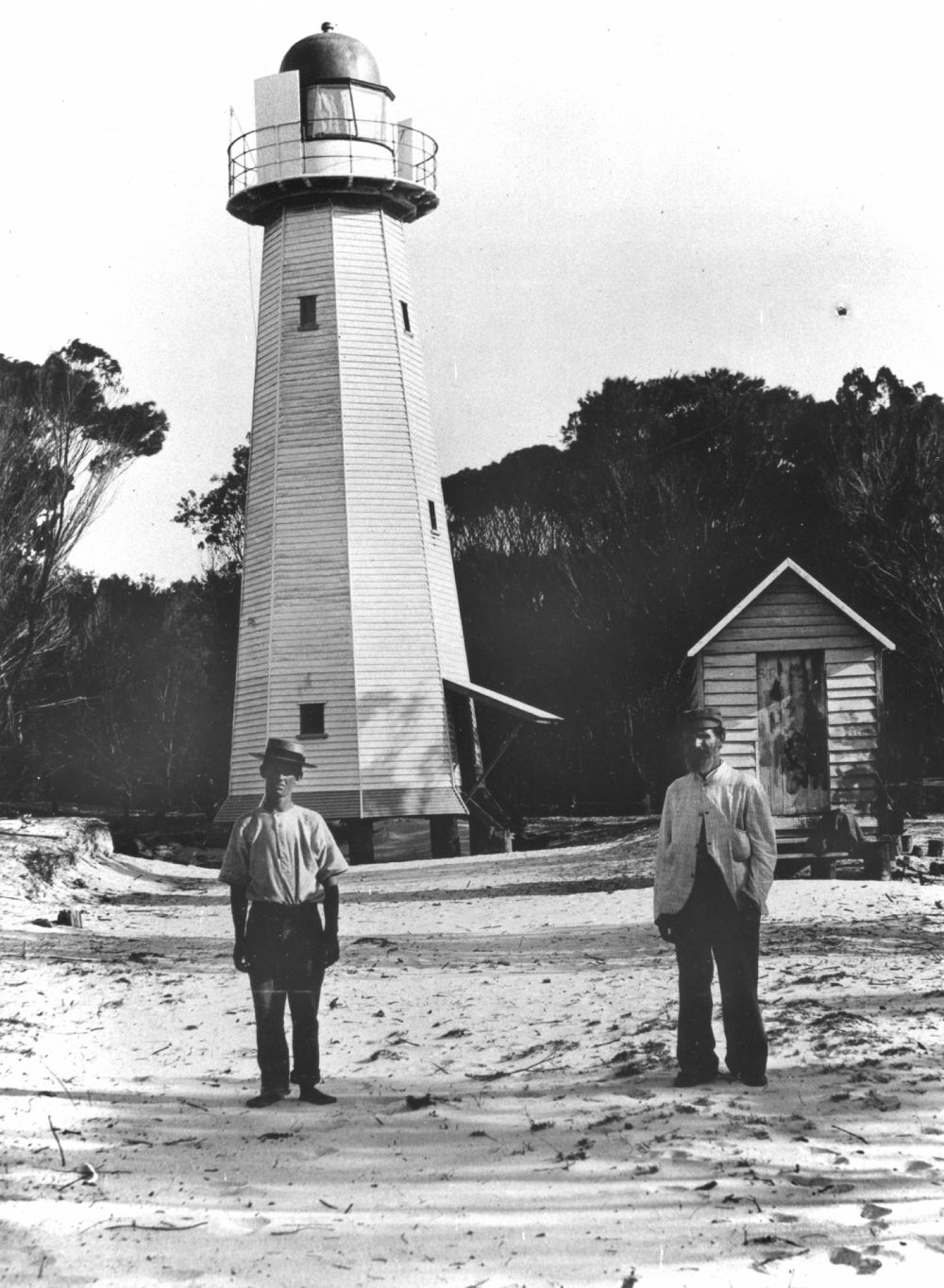Rich man, Poor man
Stories about the rich and the poor in Toowong Cemetery
Use the Toowong Cemetery map to help you visit the graves in this story. Click the grave location (portion‑section‑grave) beside each person's name to view an aerial image of the grave.
Charles Chesworth Burgess (10‑76‑15)
Charles was the son of Thomas Chesworth Burgess and Jane (née Gilbert). He was born on 9 May 1883 at the family property, Foxley at Christmas Creek near the Qld/NSW border. Charles enlisted in the Australian Imperial Force in June 1915, serving in Gallipoli, Egypt and France where he received a severe gunshot wound to his head in November 1916. After treatment in England, he returned to Australia in May 1917 and discharged three months later.
Suffering from what was then termed 'shell shock', he was denied assistance in resettling and treatment. He retired to Glen Lamington in the Lamington National Park where he became known as the 'Hermit of Lamington'. Charles was an expert bushman and was brought into the limelight in February 1937 when he was involved in the rescue of the survivors of the Stinson plane disaster in the Macpherson Ranges. Just over two years later, on 11 April 1939, Charles died in the Brisbane General Hospital less than a month before his 56th birthday.
Charles Chesworth Burgess Queensland's hermit cave-dweller, of Glen Lamington - Smith's Weekly, 20 March 1937
Dr John Henry Griffin (2A‑23‑5)
Irish-born, Dr Griffin was the son of John Griffin, a leading Dublin broker, and Florence (née McCooke). After qualifying in multiple fields of medicine in Brussels, London and Ireland, he arrived in Brisbane ca. 1889 and soon became well known for his professional skill and his general popularity.
Soon after his arrival, he joined the Brisbane Hunt Club which had been started in 1888 by Adolph Feez. On 1 July 1893 he was killed during a hunt when his horse struck the top rail of a fence, throwing the 30-year-old doctor over the fence and landing heavily on his head. Death was instantaneous.
Molyneux Henry Dickinson Nepean (1‑158‑5)
Molyneux Nepean was born on 19 April 1846, a twin and fifth son of Rev Canon Evan Nepean, later Canon of Westminster and Private Chaplain to Queen Victoria. His mother, Ann Jenner-Fust was the daughter of Sir Herbert Jenner Fust, Dean of the Arches. His grandfather, Sir Evan Nepean, 1st Baronet, as Under-Secretary of State in the Home Office in Britain was involved in the arrangements for the dispatch of the First Fleet and administration of the newly established penal colony in NSW.
After four years of military service, Lt Molyneux Nepean retired and joined the British Civil Service as a clerk before leaving London for Sydney with his new bride in 1872. He held various positions in the NSW Colonial Government, first as a clerk and later as an Assistant Land Agent for the sale of Crown Lands.
He had a troubled life and died in Brisbane Hospital at the age of 43 on 30 September 1889, following a fall at a chemist shop in South Brisbane.
Reginald Heber Roe (20‑25‑5A)
Reginald was the first vice-chancellor of the University of Queensland, holding this position from 1910-1916. He was born on 3 August 1850 in Blandford Forum, Dorset, the youngest of 10 children to John Banister Roe Esq, a linen draper and button manufacturer turned wine merchant and Mary Ann née Allies, a school mistress at a school for young ladies. The family may hay fallen on hard times as Reginald was educated at Christ's Hospital, London, at that time a school for orphans and children of indigent gentleman. His father may have died in 1869 while Reginald was head boy at the school.
After graduating from Oxford, Reginald was appointed headmaster of Brisbane Grammar School in 1876, the youngest headmaster in Australia at that time. He established cadet training and encouraged sport for his students. In July 1909 he was appointed Inspector-General of Schools for Queensland and Inspector of Grammar Schools in 1917. He died in St Martin's Hospital, Brisbane on 21 September 1926.
Reginald Heber Roe. State Library of Queensland.
Dr John Shirley (20‑25‑6)
Dr John Shirley who was born in Dorchester on 11 August 1849 to Sergeant John Shirley of the Grenadier Guards and Una (née Turner). John Shirley graduated with a Bachelor of Science from London University then trained as a teacher.
He arrived in Brisbane in 1878 and was immediately appointed headmaster of the school at Roma. The following year he was promoted to the position of Schools Inspector. He covered thousands of miles on horseback, visiting schools all over Queensland. This life gave him the opportunity to further study natural sciences, which had formed his final University course and he published many scientific papers. He was awarded the degree of D.Sc. at the age of 63.
In 1914 Dr Shirley became the first principal of the newly established Teachers' Training College in Brisbane, a position he held until retirement in 1919. He died at his residence in Bowen Hills on 5 April 1922 following a seizure.
Albert Charles Cox (20‑23‑1/2)
Albert "Bert" Cox born 8 December 1892, joined the Australian Imperial Force in May 1916, holding the rank of 2nd Lieutenant at the end of World War One. Prior to the war he was an electrical engineer. In August 1918 he received a gunshot wound to his left cheek and was sent to hospital in England for treatment. By the time he left hospital, the war was over. His wound required further treatment and he did not leave England until October 1919 and was not discharged from the Australian Imperial Force until March 1921.
He then joined the City Electric Light Co as an electrical engineer. On 29 January 1925 he was erecting new wires at the Company's substation in Ipswich Road when he touched a live wire. Death was instantaneous.
Samuel James Reilly (20‑46‑18)
Samuel Crouch, born in Middlesex, was the son of Stephen Crouch and Mary Ann (née Reeves). At the age of 19, he became an Able Seaman. He assumed the surname 'Riley' and later 'Reilly' when he went to sea. He first arrived in Sydney in 1864 as a crewman on a ship before settling in Queensland in 1869. In December 1875, he was appointed to the Queensland Lighthouse Service as coxswain of the pilot boat and Receiving Officer at Inskip Point. Samuel died on 21 October 1919 aged 80 while stationed at Comboyuro Point Lighthouse.
Lighthouse at Comboyuro Point, Moreton Island, 1906. The two gentlemen standing in front of the lighthouse are Samuel James Reilly and his son James Compton Reilly. (Description supplied with photograph) - State Library of Queensland
Albert Ensor (20‑48‑5/6)
Albert, his wife Clara and family arrived in Brisbane in June 1912. Albert, whose trade was house painter, was born in Birmingham on 5 December 1872 to John Robert Ensor and Emma Jane (née Robbins). In May 1917, at the age of 44years and 5 months, he enlisted in the Australian Imperial Force and trained as a machine gunner before eventually being deployed to France in August 1918. He stayed on in France after the Armistice to assist with the repatriation of soldiers.
On his return to Brisbane, he resumed his previous occupation of house painter. Family lore has it that he was involved in doing interior plaster work and painting in the Regent Theatre in Queen Street which opened in 1919. Albert died on 5 May 1950 at the age of 77.
Robert (Bob) Toupein (5‑96‑24)
'Bob' Toupein was born in 1886 in Gunnedah NSW where his father, Jean Toupein and later Bob himself were railway fettlers. He moved to Darwin in 1913 and opened a barber shop/billiards saloon. This was during a period of industrial and political unrest in the NT. One of the issues was lack of political representation in Federal Parliament for its residents. In 1917 Bob was elected to the Darwin Town Council and became Mayor of Darwin in 1919 but resigned in 1921. He was elected secretary of the North Australian Industrial Union and held that position until 1937 when he married and settled at Woody Point in Queensland. He died on 12 July 1949 at the age of 62, five years after suffering serious injuries in a workplace accident.
Acknowledgements
Compiled and presented by Lyn Maddock
Sources
- Family History Research - The State of Queensland
- Trove - National Library of Australia
- ancestry.com.au
- Green Mountains Bernard O'Reilly
- Burgess, Charles Chesworth, Logan Village Museum
- https://gmmd.com.au/tag/scenic-rim/ (broken)
- www.brisbanehuntclub.com (broken)
- UK, Regimental Registers of Service, 1756-1900
- New South Wales, Australia, Public Service Lists, 1858-1960
- The London Gazette, April 18, 1865
- The London Gazette, May 28, 1869
- Christ's Hospital, London
- Roe, Reginald Heber (1850–1926), Australian Dictionary of Biography
- The Australian War Memorial Collection
- Inskip Point Light and Signal Station
- Commonwealth Government records about the Northern Territory - Commonwealth of Australia (National Archives of Australia)
- Smith, Miles Staniforth Cater (1869–1934), Australian Dictionary of Biography


